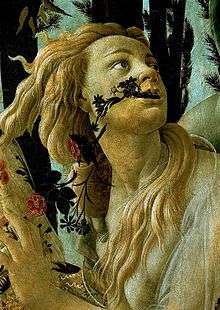Chloris (nymph)
In Greek mythology, Chloris (/ˈklɔːrɪs/; Greek Χλωρίς Khlōris, from χλωρός khlōros, meaning "greenish-yellow", "pale green", "pale", "pallid", or "fresh") was a nymph or goddess who was associated with spring, flowers and new growth, believed to have dwelt in the Elysian Fields.

"As she talks, her lips breathe spring roses: I was Chloris, who am now called Flora." Ovid
Mythology
Chloris was abducted by Zephyrus, the god of the west wind (which, as Ovid himself points out, was a parallel to the story of his brother Boreas and Oreithyia), who transformed her into a deity known as Flora after they were married. Together, they have a son, named Karpos. She was also thought to have been responsible for the transformations of Adonis, Attis, Crocus, Hyacinthus and Narcissus into flowers.[1]
Note
- Ovid, Fasti, 5. 195 ff
gollark: n. A person who holds controversial opinions, especially one who publicly dissents from the officially accepted dogma of the ~~Roman Catholic Church~~ Ericist religion.
gollark: No.
gollark: I actually follow Radical Discordian Hexicantilist Tolkeinist Ericism.
gollark: That makes you a heretic.
gollark: Ah, so you are not an Ericist.
References
- Publius Ovidius Naso, Fasti translated by James G. Frazer. Online version at the Topos Text Project.
- Publius Ovidius Naso, Fasti. Sir James George Frazer. London; Cambridge, MA. William Heinemann Ltd.; Harvard University Press. 1933. Latin text available at the Perseus Digital Library.
See also
This article is issued from Wikipedia. The text is licensed under Creative Commons - Attribution - Sharealike. Additional terms may apply for the media files.